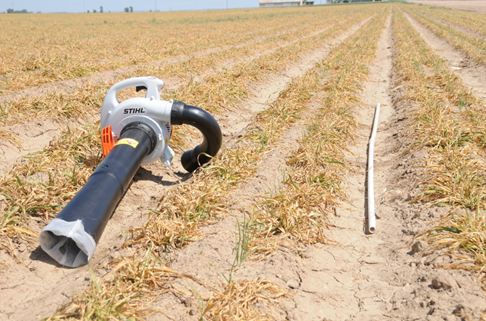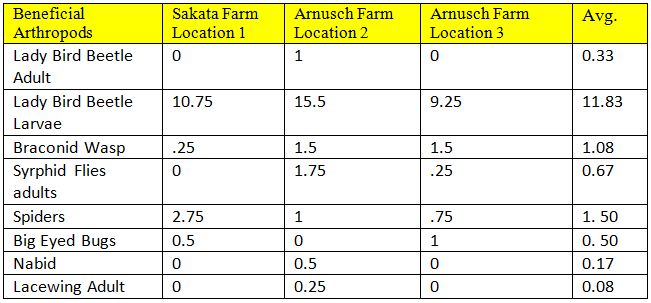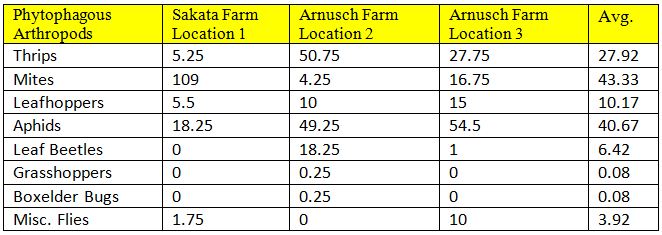Journal of the NACAA
ISSN 2158-9429
Volume 5, Issue 1 - May, 2012
Insect and Arachnid Population Diversity in Onion Companion Crop
- Gourd, T.R., Extension Agent for Adams County, Colorado State University Extension
Julian, J.J., Extension Agent for Douglas County, Colorado State University Extension
ABSTRACT
Onion production across the United States has been impacted by Iris Yellow Spot Virus (IYSV) which is vectored by the onion thrips (Thrips tabaci). Reducing thrips populations can sometimes help reduce infection rate of IYSV in onions. In Colorado, companion crops (living mulch) such as barley planted with onions to reduce wind and water erosion has sometimes had an effect on thrips populations. The objectives of this study are to determine 1) which thrips predators and parasites inhabit the barley companion crop; 2) what other insects/arachnids dwell in this living mulch; and 3) if there is a relationship between predator/parasite and thrips populations. Three onion field locations were sampled during 2011 that used barley as a companion crop in Weld County, Colorado. Each field location had four randomly selected areas of the field sampled with the insectavac on 6/14/2011 and 6/15/2011. Eight beneficial predator and parasite families were identified from the three fields sampled. The average of all populations of insects and arachnids at all locations revealed that ladybird beetle larva were the most numerous followed by spiders, braconid wasps, syrphid flies, big eyed bugs, ladybird beetle adults, nabids, and lacewings. No statistical differences in beneficial populations were seen between the three locations. Six plant feeding insect families and one phytophagous mite family were found in the field samples. Only mite and thrips populations varied significantly between the three locations. Later in the season, thrips populations on 7/28/11 ranged from 0.92 to 15.4 thrips per plant. In a non-companion crop planted field, 20.5 thrips were found per onion plant. No correlation between predator/parasite and thrips populations were detected in any companion crop location. This study did quantify that eight beneficial predator/parasite families, six plant feeding insect families and one phytophagous mite family were found inhabiting living mulch in one or more companion crop onion field locations in Weld County in 2011.
Introduction
Across the United States, onions are often grown with companion crops such as barley (living mulch) to provideseedling onion plants protection from waterand wind erosion.(1, 2). Frequently, barley is planted prior to, or during the onion seed planting operation. The rapidly emerging barley protects newly sprouted onion plants from wind, sand blasting and occasionally small hail injury that commonly occurs in the early spring along the Front Range of Colorado. The barley also significantly reduces soil loss in seeded onion fields. Onion producers and university researchers from many western states have sometimes witnessed a reduction in thrips populations in these companion crop (living mulch) planted fields.
Objective
This study was set up to determine if beneficial populations of insects and arachnids found in a barley companion crop grown with onions could be affecting thrips populations at various field locations in Colorado. Parameters of this study include:
- Determine which thrips predators and parasites inhabit the barley companion crop.
- Determine what insects/arachnids pests dwell in this living mulch.
- Determine if there is a relationship between predator/parasite and thrips populations.
Methods
Three onion field locations were found that used barley as a companion crop (living mulch) in Weld County, Colorado. The Sakata farm location 1 used sprinkler irrigation and was located just north of Weld County Road 2 and east of Weld County Road 21. The GPS coordinates are 40°01’ 03.15” N and 104° 51’ 10.37 at 5012 feet above sea level. At this location, barley was planted on March 3, and the onions planted on March 10, 2011. Intensity herbicide was applied on 5/23 and again on 6/3 to kill the barley. Lannate insecticide was sprayed on 7/21 and again on 8/18/2011 for thrips control.
The Arnusch farm location 2 used furrow irrigation and was located on the southwest corner of Weld County Road 69 and Weld County Road 14. The GPS coordinates are 40° 04’ 59.01” N and 104° 24’ 52.74” at 4838 feet above sea level. At this location, barley was planted on March 2 and the onions planted on March 23. Select herbicide was applied on May 17, 2012 to kill the barley at all of the four Arnusch farm locations that had a companion crop. The insecticide Movento was sprayed on 6/20 and 7/8; Radiant on 6/30 and 7/29 and Lannate on 7/17 and 8/10/2011.
The Arnusch farm location 3 used sprinkler irrigation and was located on the southwest corner of Weld County Road 65.5 and Weld County Road 16. The GPS coordinates are 40° 05’ 46.05” N and 104° 26’ 37.76” at 4818 feet above sea level. At this location, barley was planted on March 12 and the onions planted on March 26. The insecticide Movento was sprayed on 6/15 and 6/27; Radiant on 6/27 and 7/12 and Lannate on 7/24 and 8/9/2011.
The Arnusch farm location 5 with no companion crop planted with onions was located at 40° 05’ 12.25” N and 104° 24’ 58.54 and 4836 feet above sea level. This location was used for the thrips population assessment on 7/28/2011. At this location, the onions were planted on March 25. The insecticide Movento was sprayed on 6/11 and 6/20; Radiant on 7/1 and 7/31 and Lannate on 6/20 and 7/10/2011.
Each location had four randomly selected areas of the field sampled with an insect vacuum. Field locations 1 and 2 were sampled on 6/14/2011 and location 3 was sampled on 6/15/2011. The sample size was one row (2.5 feet) wide by 10 feet. The onions had three to four true leaves at the time of the sampling.
Equipment used to collect samples was a Stihl gas powered BG56 Shredder/Vacuum with a no thrips insect screen liner (192 micron polyethylene monofilament 181 x 181 mesh) attached to the suction tube by rubber bands (Figure 1). The liner captured plant parts and arthropods inhabiting the barley and onions. An insect vacuum (insectavac) was created in the late 1970’s by J. Ellington, New Mexico State University (3) and modified by Colorado State University Extension entomologist, Bob Hammon. Traditional hand-net samples catch only 8% of total insects and the insectavac catch efficiency ranges from 14 to 64% with an average of 32.6% (3). The fine mesh bags were emptied into one gallon zip lock freezer bags and a cooler containing blue ice kept samples cool while in the field. A ten foot piece of PVC pipe was used as a measuring device to insure only a ten foot row was sampled. Samples were examined using a Nikon SM2800dissecting microscope with 6.3 x 10 magnification. Fine meshed laboratory screens were used to separate insects and arachnids from soil debris and plant material (Figure 2).
Figure 1. Stihl gas powered BG56 Shredder/Vacuum.
Figure 2. Sample preparation and counting organisms.
A thrips population evaluation counted the number of thrips per plant on 7/28/11 at the three companion crop (living mulch) locations and also one field location where no companion crop was used. One hundred plants were randomly sampled at each location and checked for all stages of thrips. Data was analyzed using Analysis of Variance and the Tukey HSD All Pairwise Comparisons Test.
Results
The time required to vacuum each sample site was approximately one minute. Placing the sample in a gallon sized bag added another minute of time. The actual process of examining just one sample for insects and arachnids required approximately two hours. Eight beneficial predator and parasite families were identified from the three field locations. The average of all populations of insects and arachnids at all locations revealed that ladybird beetle larva (Coccinellidae) were the most numerous followed by spiders, braconid wasps (Diaeretiella), syrphid flies (Syrphidae), big eyed bugs (Geocoridae), ladybird beetle adults (Coccinellidae), damsel bugs (Nabidae), and green lacewing adults (Chrysopidae) (Table 1 and Figure 3). No statistical differences were seen between beneficial populations at any location. Six plant feeding insect families and one phytophagous mite family were found in the field samples. The average of all populations of insects and arachnids at all locations revealed that phytophagous mites were the most numerous, followed by aphids (Aphidae), thrips (Thripidae), leafhoppers (Cicadellidae), leaf beetles (Chrysomelidae), miscellaneous flies, one grasshopper and one boxelder bug adult (Table 2 and Figure 4). Other than the thrips, these insects and mites would normally be found feeding in barley and not on onions. Only mite and thrips populations varied significantly between the three companion crop locations (Figure 5 and 6).

Figure 3. Beneficials Found on 6/14/11 at Companion Crop Field Locations.

Figure 4. Pests Found on 6/14/11 at Companion Crop Field Locations.

Figure 5. Mite Populations on 6/14/11at Companion Crop Field Locations.

Figure 6. ThripsPopulations on 6/14/11at Companion Crop Field Locations.
Thrips populations were evaluated on 7/28/11 by sampling 100 plants from each of four locations in the four fields. Numbers ranged from 1.0 to 15.4 thrips per plant in companion crop planted fields. In one non-companion crop planted field (Arnusch 5) located near a test location, 20.5 thrips were found per onion plant. This was significantly higher than all other onion companion crop field locations (Figure 7). Because the thrips evaluation on 7/28/2011 occurred after a number of insecticide applications were made to the onion crop, no correlation between the companion crop (living mulch) fields thrips population compared to a non companion crop planted field, could be drawn. This thrips evaluation only showed efficacy of the previous applied insecticides.

Figure 7. Thrips Populations on 7/28/11.
Little to no IYSV was found at any field locations sampled in 2011. No correlation between beneficial insect and arachnid populations sampled on 6/14 -6/15 and thrips populations was found. However, this study did document that eight beneficial predator/parasite families, six plant feeding insect families, and one phytophagous mite family were inhabiting one or more companion crop onion field locations in Weld County in 2011.
Table 1. Average number of beneficial insects and arachnids per 10 foot row (25 square feet) Locations 1 and 2 sampled on 6/14/2011; Location 3 on 6/15/2011.
Table 2. Average number of insects and arachnids per 10 foot row (25 square feet) Locations 1 and 2 sampled on 6/14/2011; Location 3 on 6/15/2011.
References
1. Zandstra, Bernard, Michigan State University, Horticulture, “Time to kill barley cover crops in barley”, Integrated Pest Management Resources, Vegetable Crop Advisory Team Alert, Current news articles for vegetable production, 5/12/2010.
2. Stivers, Lee, Crop Profile: Onions in New York, Cornell Cooperative Extension, 249 Highland Ave., Rochester, NY 14620.
3. Ellington, J.J., Kiser, K., Cardenas, M., Duttle, J., and Lopez, Y. 1984. The insectavac: A high-clearance, high-volume arthropod vacuuming platform for agricultural ecosystems, Environmental Entomology 13 (1), 259-265.
Acknowledgements
I would like to thank Robert and Bob Sakata for allowing me to use an onion field in this study. I would also like to thank Marc Arnusch for the use of his onion fields for this project.




